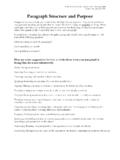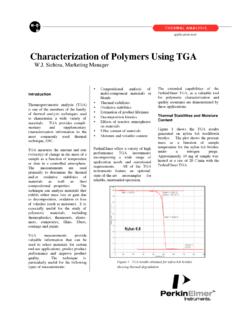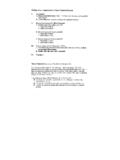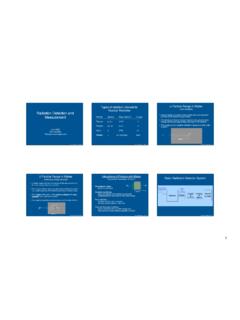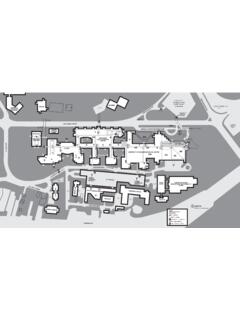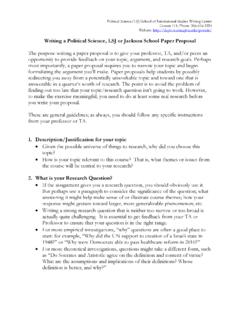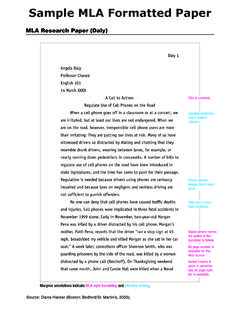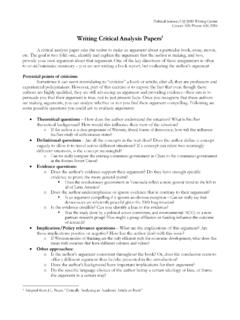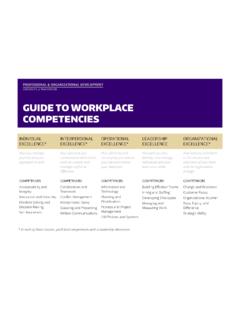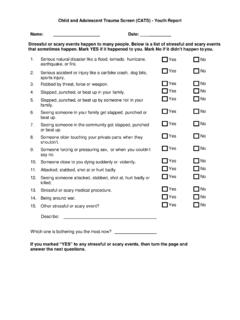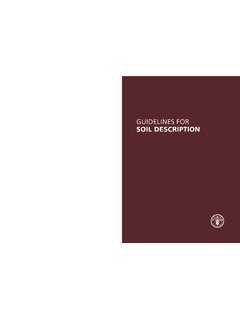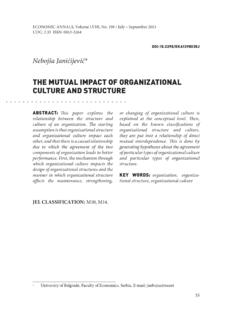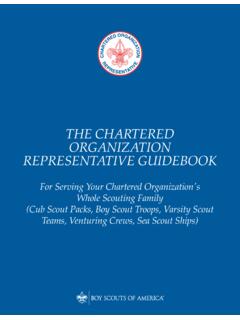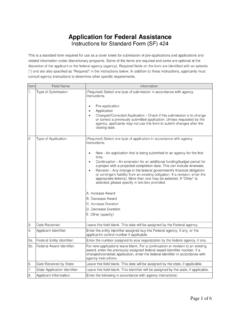Transcription of How to Structure & Organize Your Paper
1 Page 1 of 8. How to Structure & Organize Your Paper Organizing Your Thoughts Making sense out of your observations about a text is a difficult task. Even once you've figured out what it is that you want to say, you are left with the problem of how to say it. With which idea should you begin? Should you address the opinions of other thinkers? As to that stubborn contradiction you've uncovered in your own thinking: what do you do with that? Writing papers in college requires that you come up with sophisticated, complex, and even creative ways of structuring your ideas. Accordingly, there are no simple formulae that we can offer you that will work for every Paper , every time. We can, however, give you some things to think about that will help you as you consider how to Structure your Paper .
2 Let Your Thesis Direct You Begin by listening to your thesis. If it is well-written, it will tell you which way to go with your Paper . Suppose, for example, that in responding to Richard Pipes' book, The Russian Revolution, you have written a thesis that says: The purpose of the Russian Revolution was not only to revise Russia's class system, but to create a new world, and within that world, a new kind of human being. This thesis provides the writer (and the reader) with several clues about how best to Structure the Paper . First, the thesis promises the reader that it will argue that the Russian Revolution was not simply a matter of class. The Paper will therefore begin by saying that although the destruction of the Russian class system was important to the heart of this revolution, it was not its final goal.
3 The rest of the Paper will be broken into two parts: the revolution's vision of world communism, and (even more important) its vision of the new homo sovieticus - or soviet human being. I say that this idea of the homo sovieticus is more important than the idea of a new world order not because the Russian revolutionaries thought so, but because the writer seems to say so in her thesis. Read the thesis sentence again. Note how the emphasis falls on the last phrase: "A new kind of human being." The emphasis in this sentence dictates the emphasis of the entire Paper . We expect, as readers, that the other issues taken up in this Paper - the destruction of class, the invention of a new world order - will be discussed in terms of creating a new kind of human being.
4 In other words, we won't be given simply a description of how this revolution intended to affect world economy; we will be given a description of how this revolution intended to manipulate economic conditions so that they would be more favorable to the evolution of the new Soviet person. Sketching Your Argument While your thesis will provide you with your Paper 's general direction, it will not necessarily provide you with a plan for how to Organize all of your points, large and small. Here it might be helpful to make a diagram or a sketch of your argument. In sketching your argument your goal is to fill the page with your ideas. Begin by writing your thesis. Put it where your instincts tell you to: at the top of the page, in the center, at Courtesy Odegaard Writing & Research Center Adapted from ~writing/materials/student/ac_ Page 2 of 8.
5 The bottom. Around the thesis, cluster the points you want to make. Under each of these points, note the observations you've made and the evidence you'll use. Don't get nervous when your sketch starts to look like a mess. Use arrows. Draw circles. Take up colored pens. Any of these methods can help you to find connections between your ideas that otherwise might go unseen. Working from your sketch, try to see the line of reasoning that is evolving. Sketching is an important step in the writing process because it allows you to explore visually the connections between your ideas. If you outline a Paper too early in the writing process, you risk missing these connections. You line up your argument - A. B. C. - without fully understanding why.
6 Sketching your argument helps you to see, for example, that points A and C really overlap and need to be thought through more carefully. Outlining Your Argument When you've finished your sketch, you're ready to make an outline. The task of your outline is to find your Paper 's "best Structure ." By "best Structure ," we mean the Structure that best supports the argument that you intend to make. When you are outlining a Paper , you'll have many options for your organization. Understand, however, that each choice you make eliminates dozens of other options. Your goal is to come up with an outline in which all your choices support your thesis. In other words, your goal is to find the "best Structure " for your argument. Treat the outline as if it were a puzzle that you are trying to put together.
7 In a puzzle, each piece has only one appropriate place. The same should be true of your Paper . If it's easy to shift around your ideas - if paragraph five and paragraph nine could be switched around and no one would be the wiser - then you haven't yet found the best Structure for your Paper . Keep working until your outline fits your idea like a glove. When you think you have an outline that works, challenge it. I've found when I write that the first outline never holds up to a good interrogation. When you start asking questions of your outline, you will begin to see where the plan holds, and where it falls apart. Here are some questions that you might ask: Does my thesis control the direction of my outline? Are all of my main points relevant to my thesis?
8 Can any of these points be moved around without changing something important about my thesis? Does the outline seem logical? Does my argument progress, or does it stall? If my argument seems to take a turn, mid-stream, does my thesis anticipate that turn? Do I have sufficient support for each of my points? Have I made room in my outline for other points of view about my topic? Does this outline reflect a thorough, thoughtful argument? Have I covered the ground? Modes of Arrangement: Patterns for Structuring Your Paper We've told you that there are no formulae for structuring your Paper . We've put you through the very difficult task of finding a Structure that works for you. Having done all of this, we are now ready to say that there indeed exist some general models for arranging information within a Paper .
9 These models are called "modes of arrangement." They describe different ways that information might be arranged within a text. Courtesy Odegaard Writing & Research Center Adapted from ~writing/materials/student/ac_ Page 3 of 8. The modes of arrangement include: Narration: telling a story Description: relating what you see, hear, taste, feel, and smell Process: describing a sequence of steps necessary to a process Definition: illustrating the meaning of certain words or ideas Division and Classification: grouping ideas, objects, or events into categories Compare and Contrast: finding similarities and/or differences between topics Analogy: making a comparison between two topics that initially seem unrelated Cause and Effect: explaining why something happened, or the influence of one event upon another **SEE THE OWRC HANDOUT SECTION FOR SELECT Paper MODEL OUTLINES**.
10 Your entire Paper might be a compare and contrast Paper , or you might begin a Paper by describing a process, and then explore the effect of that process on something else. Try to be aware of what your purpose is at any given point of your Paper , and be sure that this purpose is arranged appropriately. It confuses the reader, after all, if you muddle together your description of a process with its effects. Constructing Paragraphs Imagine that you've written your thesis. You've interrogated your outline. You know which modes of arrangement you intend to use. You've settled on a plan that you think will work. Now you have to go about the serious business of constructing your paragraphs. You were probably told in high school that paragraphs are the workhorses of your Paper .
